Neon pothos plants are beautiful, colorful houseplants that are perfect for beginners looking to start their own indoor garden. They require minimal care and maintenance and thrive indoors all year round.
This guide will cover how to grow and care for the neon pothos indoors.
Neon Pothos Plant Overview
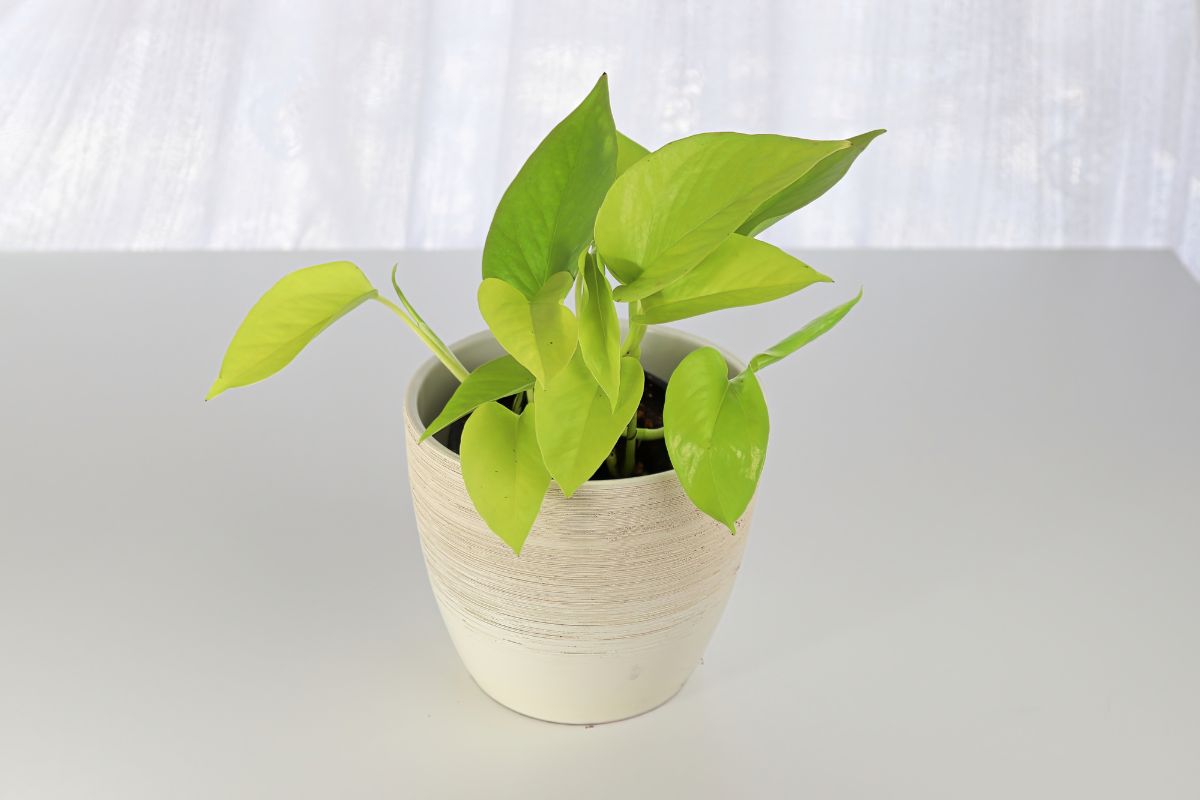
The Neon Pothos is botanically identified as the Epipremnum aureum “Neon.” It Is native to Southeast Asia, as well as the Polynesian and the Solomon Islands.
Like many other pothos varieties, the neon pothos are great plants for those without green thumbs. They are lovely to look at, adaptable, and literally impossible to kill.
Neon Pothos Plant Care Guide
Soil for the Neon Pothos
A good soil bed is a priority for a happy neon pothos. The potting soil mix should be rich in nutrients, loose for aeration, and well-draining.
Keep the soil moist for a healthy plant, but excess water should drain out. It doesn’t like soggy or waterlogged soil as it could lead to root rot.
Check the soil by putting your finger into the top couple inches of soil to test if it’s dry.
The neon pothos can also be cultivated in water, but they will not grow as quickly as if it were planted in potting soil. Spring is a great time to plant your neon pothos.
The soil pH level should ideally measure between 6.1 and 6.5, which is slightly acidic.
Temperature for the Neon Pothos
The ideal temperature for your neon pothos should measure between 65° and 75° Fahrenheit.
The neon pothos can manage 55°F, but temperatures that drop lower than this may lead to stunted growth in this tropical plant. The leaves may also turn black.
They should be kept away from drafts, heating or air conditioning units or vents, as well as anything that can stress the plant.
Light for the Neon Pothos
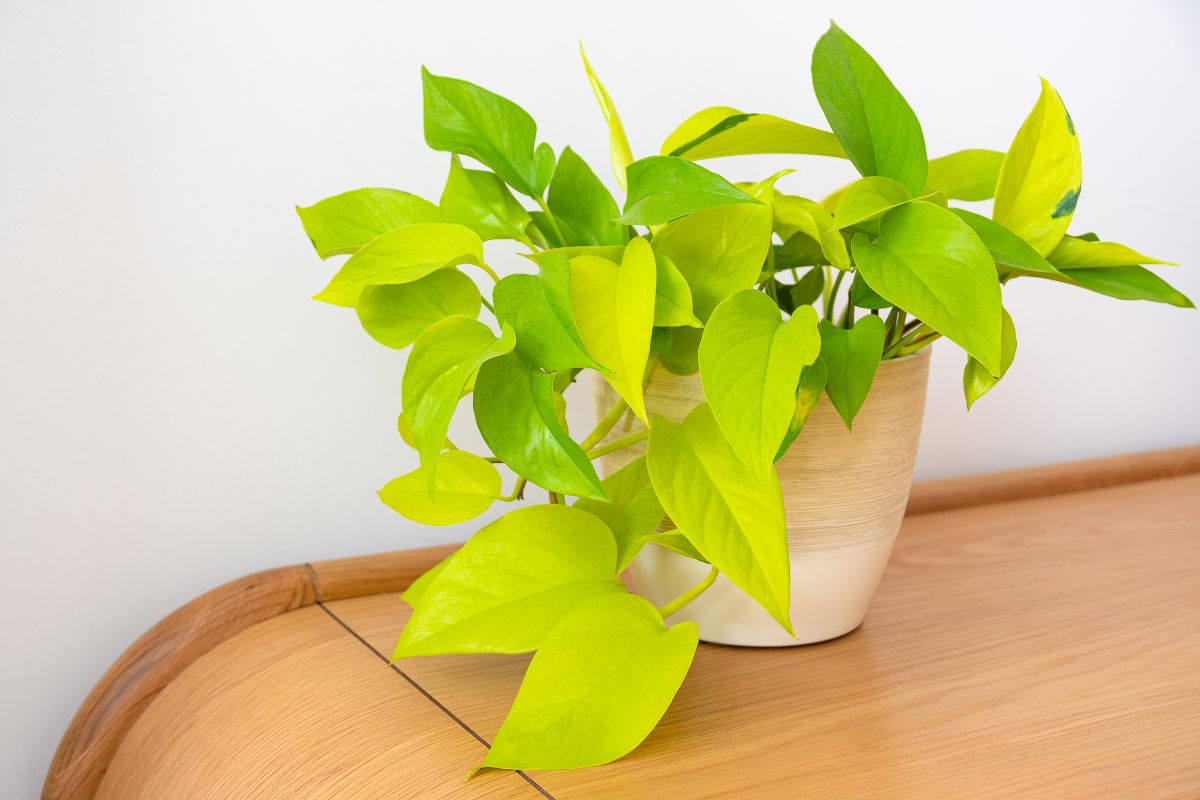
The neon pothos is adaptable to a variety of environments. They can manage and even thrive with all kinds of light exposure.
The only exception will be direct sunlight exposure. Direct light exposure can scorch leaves, causing them to wilt, and eventually kill the foliage.
They will survive in low-light conditions, but they will thrive in bright, indirect light. If you give pothos sufficient access to indirect bright light, you will encourage leaf variegation and a faster growth rate.
Water for the Neon Pothos
A neon pothos enjoys a certain tolerance to drought and can manage without water for a couple of weeks, maybe even three during the winter.
If you live in a warm climate or during the hotter seasons, you will need to check the soil bed every three to four days and water if it is dry.
If you forgot to water, check the foliage for drooping or even a bit of curling. If you notice leaves drooping and curling, water your pothos immediately because it doesn’t have enough water.
One way to avoid under or overwatering is to organize a regular watering schedule for your pothos.
Humidity for the Neon Pothos
Higher humidity levels are not mandatory for a healthy neon pothos, but they won’t harm the plant either.
If leaves begin to turn brown or you see brown leaf tips, you may have a low humidity problem.
Low humidity can be fixed easily by using a humidifier. If you don’t have one, you can place a pebble tray underneath the pot container.
Fill a tray with pretty stones and fill it with water about three-quarters of the way. Place the pothos with the container on the tray, making sure that the container does not actually come into contact with the water or you’ll have waterlogged soil.
A tray of water will increase the humidity around the plant. Other options include placing the plant in a group of plants where a microclimate is created among them with higher humidity levels.
Placing a container of water near the pothos will help. You can also mist your neon pothos, although it will not resolve humidity difficulties.
Fertilizer for the Neon Pothos
A basic liquid houseplant fertilizer can be used to feed your neon pothos monthly during the growing season from March through September.
Avoid feeding your plant during the winter months during its dormancy period.
Repotting the Neon Pothos
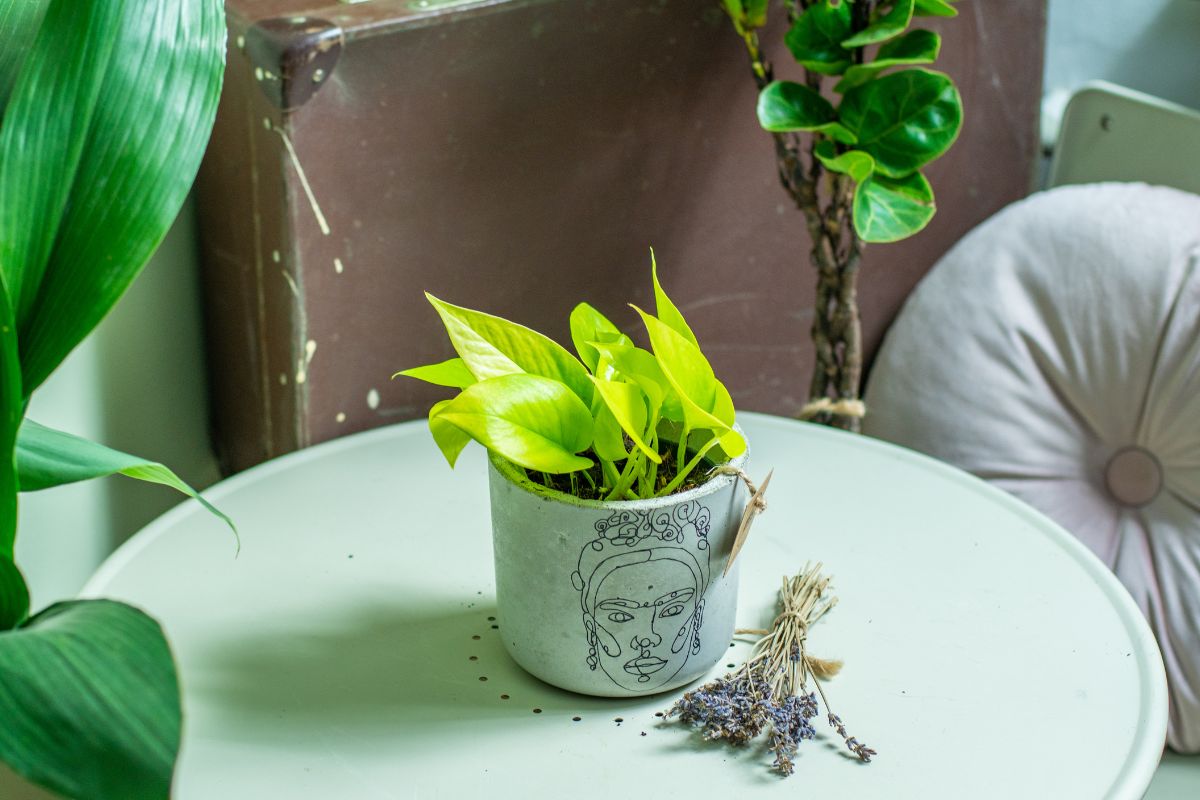
With the best environmental conditions, the neon pothos will be a rapid grower, however, you can keep it in its original pot for the first 12 to 18 months.
You will need to repot the neon pothos when the roots begin to grow out the pot’s drainage holes or the soil’s surface.
Pruning the Neon Pothos
As a vine plant, your neon pothos can use a trim if it begins to look leggy, and you prefer a fuller look. Trim vines several inches above the leaves.
Trim away any vines without foliage. You can also trim the vine tips of any vines that you feel are too long.
Propagating the Neon Pothos
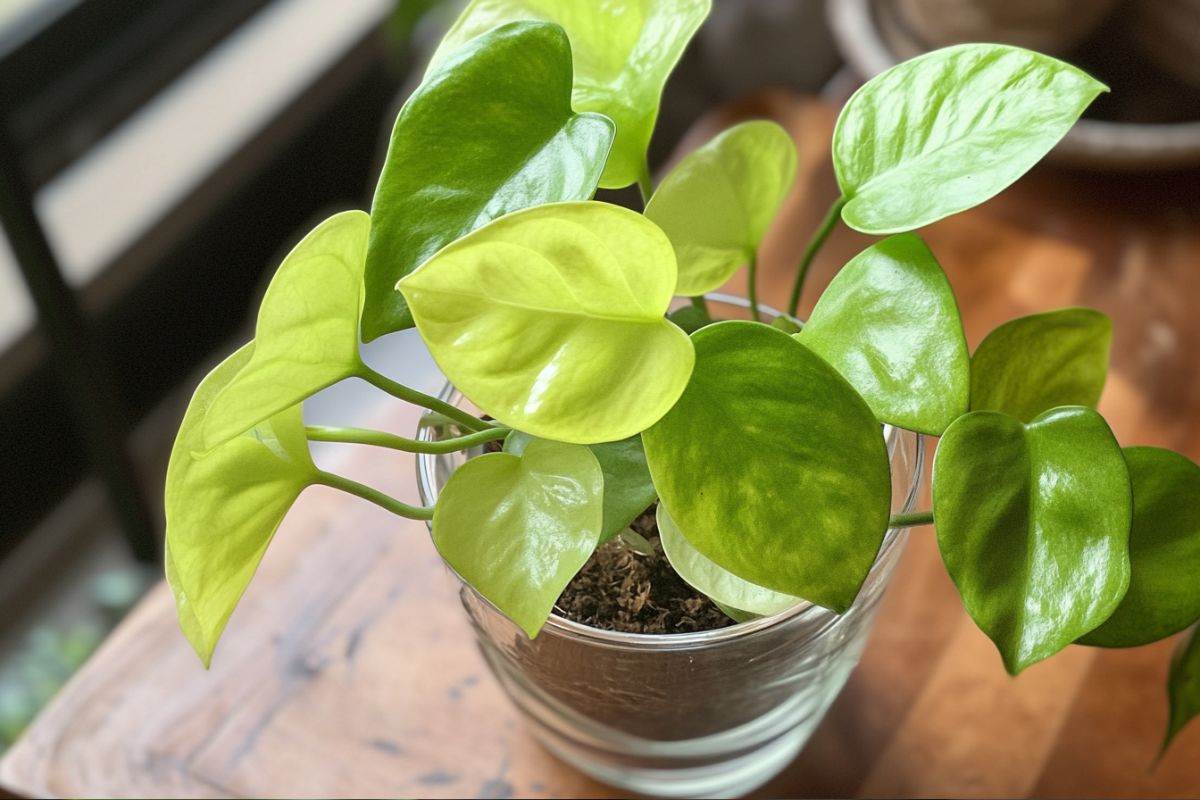
This is a very easy plant to propagate. Ideally, you should propagate during the growing season from March through September.
Here is how to propagate the neon pothos in water and later transplant them to soil:
- The easiest way to propagate is by using stem cuttings. Cut a section of neon pothos vine with two to three leaves on it.
- Cut the section into smaller pieces, each with an individual leaf.
- Trim the leaf so that the leaf growth node is exposed.
- Place them in water with the leaf nodes submerged, but the foliage remains above the water.
- Check for root growth once in a while.
- Once your new roots have grown about an inch, you can transfer the plantlet to potting soil.
Neon Pothos Toxicity and Pets
Similar to the golden pothos plant, the neon pothos contains insoluble calcium oxalates that are toxic to pets, such as cats and dogs. They can become ill after eating the leaves.
Poisoning symptoms include vomiting, diarrhea, excessive salivation, drooling, lethargy, weakness, and even death. Be sure to call a veterinarian immediately if your pet ingests any part of the plant.
Neon Pothos Problems and Pests
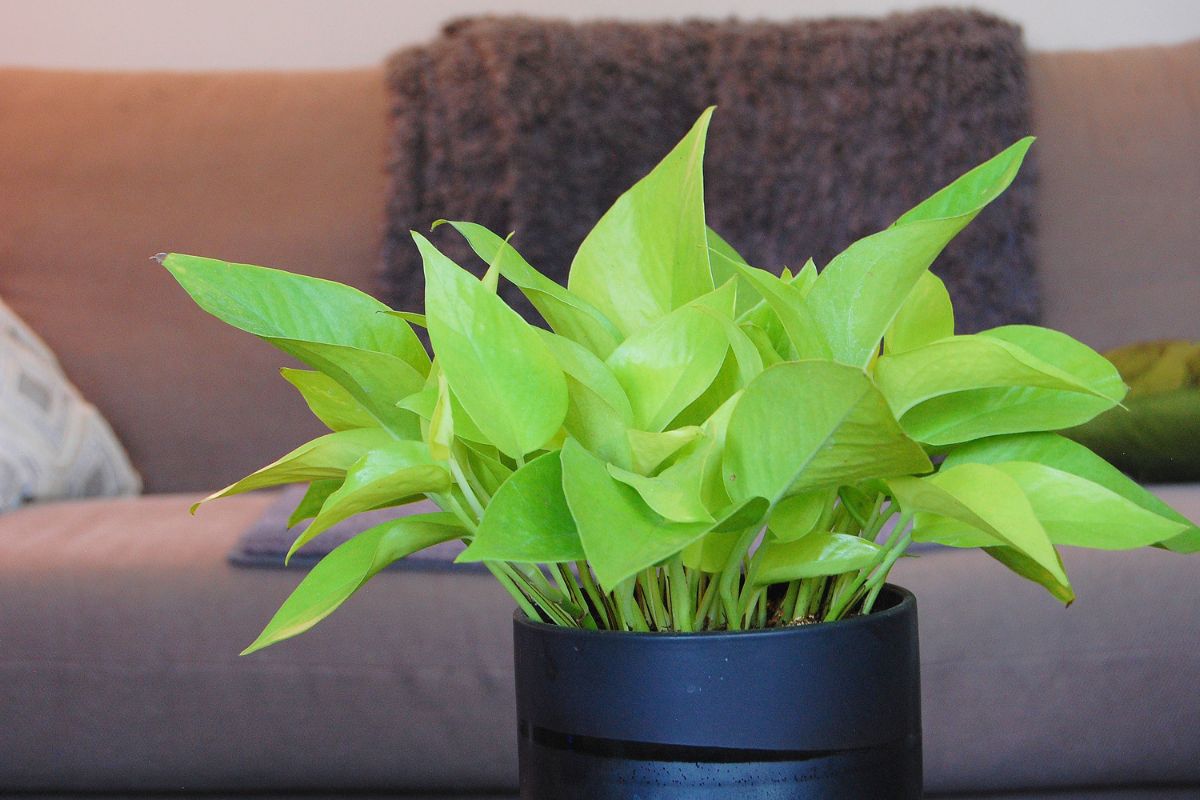
All plants will give telltale signs that they are unhappy, stressed, or having difficulty. The neon pothos may exhibit some of the following characteristics:
- Brown leaves that appear crispy – If the leaf tips are turning brown and appear to be dry and crispy to the touch, you most likely have a humidity problem, and the air is too dry. Try a pebble tray, humidifier, or even move your plant to a nice steamy bathroom or kitchen.
- Leaves curl or droop – When neon pothos leaves begin to curl or droop, your plant is telling you that it’s thirsty. Curling leaves or drooping leaves are a telltale sign that your plant needs water.
- Leaves are thinning out – If the foliage is not receiving adequate light, it will start to thin out. Move your plant to a brighter location where sun exposure is indirect.
- Leaves turn yellow and wilt – Wilting and yellow leaves are due to overwatering. One way to combat this is to soak your neon pothos and then allow it to drain out in a sink before returning it to its preferred spot.
- Pest infestation – Common plant pests such as spider mites, mealybugs, or scale insects should be treated immediately with an organic insecticide such as neem oil.
- Plant diseases – Phytophthora is the most common disease to afflict the neon pothos, which is the rotting of its root ball. Black or brown leaves may be an indication of this root rot. Usually, overwatering is at fault. It is best to dispose of the plant.
Maintenance Tip: Clean the neon pothos foliage every two to three weeks with a damp cloth. It’s to remove dust and dirt that will aid the plant in its process of photosynthesis.
Neon Pothos Care Final Thoughts
All in all, the neon pothos is easy to grow and care for. They’re forgiving when it comes to forgetfulness and maintenance. You’ll find yourself enjoying this beautiful houseplant for years to come!
For other guides for pothos plants, check these out:
- Guide to Pothos Varieties
- Manjula Pothos Care Guide
- Marble Queen Pothos Care Guide
- Silver Pothos Care Guide
Neon Pothos FAQs
Do neon pothos grow fast?
Yes, neon pothos grow fast, about 1 to 2 feet per month with proper care. They also require little maintenance, so they’re perfect for beginners. The basic requirements are to keep the soil moist and provide it bright indirect light. Give it above average humidity and it can grow quickly.
How big does neon pothos get?
Neon pothos grow up to 5-6 feet long, and they grow relatively quickly. If you plant them indoors, they should be kept in a bright, sunny window, but not exposed to direct sunlight.
How do you make neon pothos more neon?
To make the neon pothos leaves more neon, give it more bright indirect light. If they receive too little light, the leaves will turn dull, brown or even yellowish green. To keep them healthy and growing, provide them with enough bright light.
Does neon pothos like to be misted?
Neon pothos love to be misted when it’s hot and dry. The best way to mist them is to use a spray bottle filled with rainwater or distilled water.
Does neon pothos like bright light?
Yes, neon pothos thrive under bright lights, but it needs to be indirect. If you want to grow them indoors, place them by a window sill where they receive plenty of indirect sunlight and natural lighting through windows. However, do not give them direct sunlight unless you want them to burn.
How often should you water a neon pothos?
Neon pothos usually need to be watered once a week or two, but it depends on your local climate. The temperature and amount of light around the plant will affect when you need to water it. This plant needs to be watered when the soil is dry. Test your soil by putting your finger a couple inches into the soil to see if it’s dry. If the soil is dry, give it water.
Why does my neon pothos have yellow leaves?
If you notice some yellow leaves on your neon pothos, then it usually means that it’s been overwatered. The soil should be watered so it’s moist, but the excess water needs to be able to drain out of the pot. Waterlogged soil will lead to root rot and the yellow leaves.


